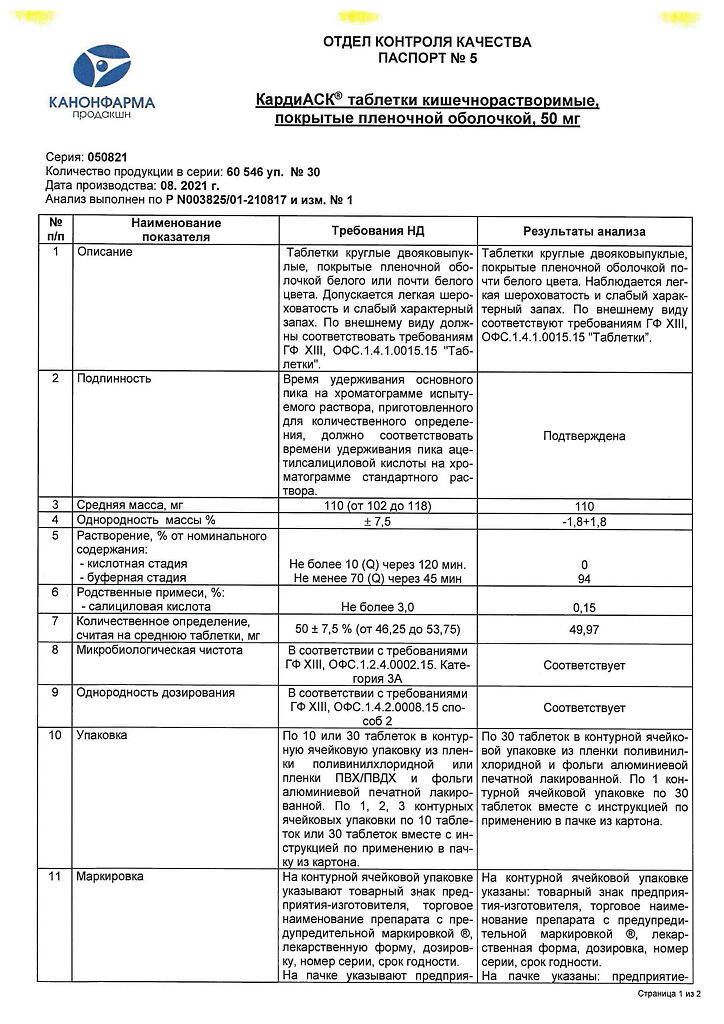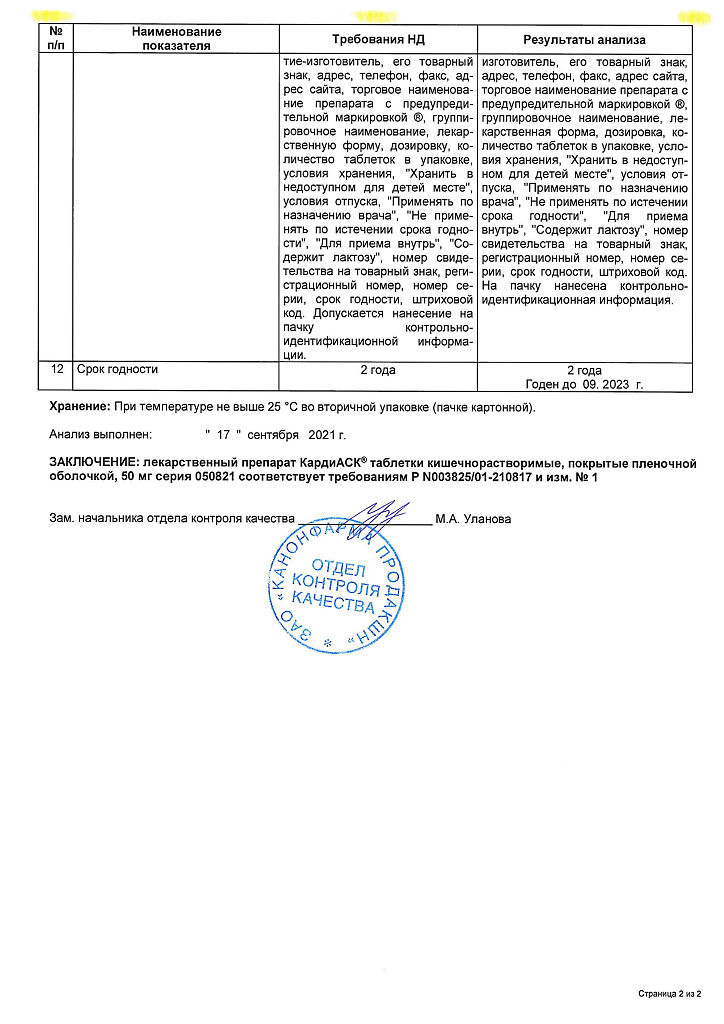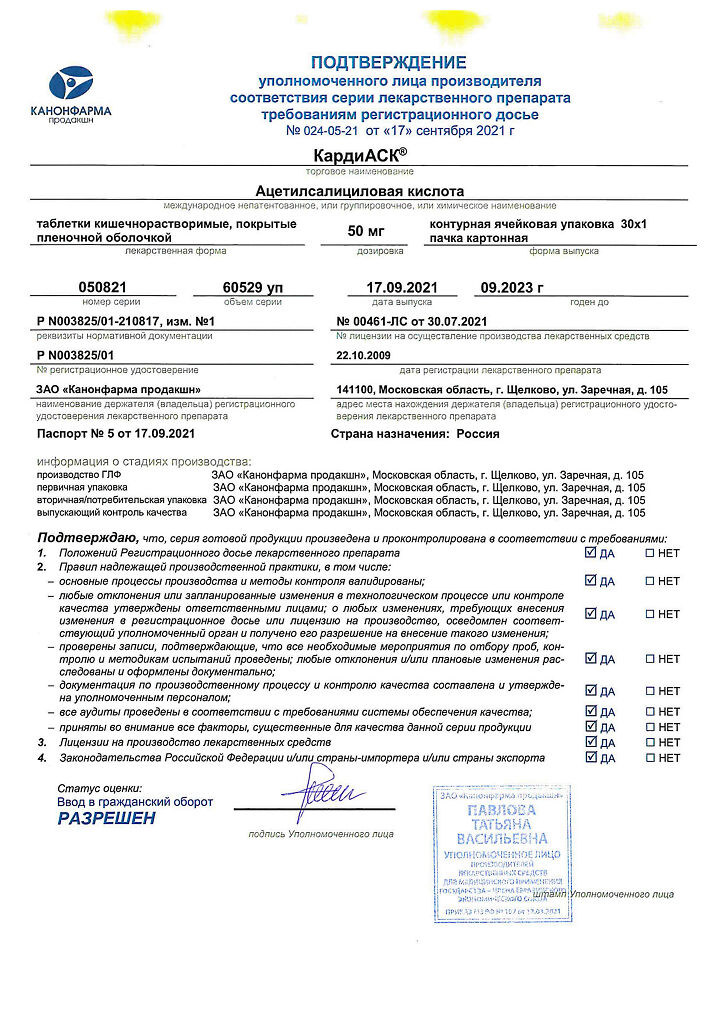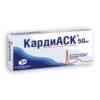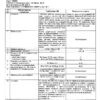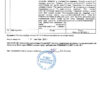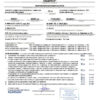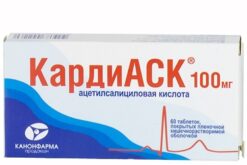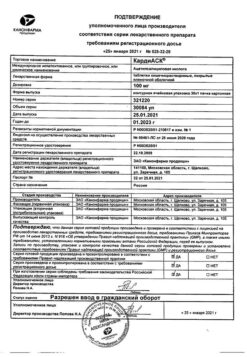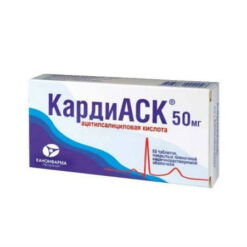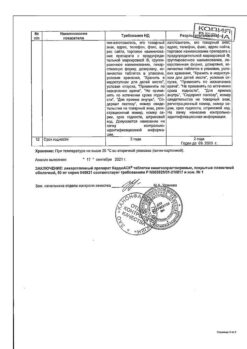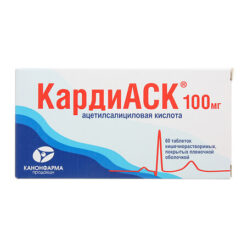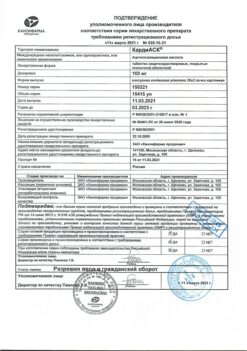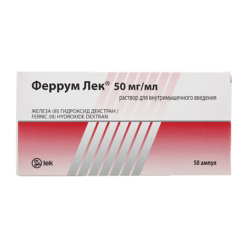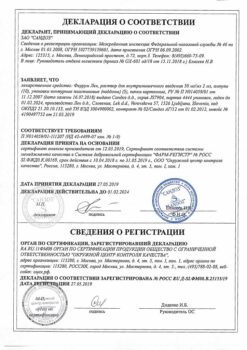No products in the cart.
CardiASC, 50 mg 30 pcs
€2.54 €2.12
Description
Pharmacotherapeutic group:
A nonsteroidal anti-inflammatory drug (NSAID).
ATX code: B01AC06.
Pharmacological properties
Pharmacodynamics
. The mechanism of antiplatelet action of acetylsalicylic acid (ASA) is based on irreversible inhibition of cyclooxygenase (COX-1), resulting in blocked synthesis of thromboxane A2 and suppressed platelet aggregation. The antiplatelet effect develops even after a low dose of the drug and lasts for 7 days after a single dose. It is believed that ASA has other mechanisms of platelet aggregation inhibition, which expands the field of its use in various vascular diseases. At high doses, ASK also has anti-inflammatory, antipyretic and analgesic effects.
Pharmacokinetics
After oral administration, ASK is quickly and completely absorbed from the gastrointestinal tract (GIT). ASK is partially metabolized during absorption. During and after absorption ASA is converted to the main metabolite, salicylic acid, which is metabolized mainly in the liver under the influence of enzymes to form metabolites such as phenylsalicylate, salicylic acid glucuronide and salicyluric acid found in many tissues and in the urine. In women, the metabolic process is slower (less enzyme activity in serum). The maximum concentration of ASA in blood plasma is reached within 10-20 minutes after oral administration, and that of salicylic acid – within 0.3-2 hours.
Due to the fact that the tablets are covered with an acid-resistant coating, ASK is not released in the stomach (the coating effectively blocks dissolution of the drug in the stomach), but in the alkaline environment of the duodenum. Thus, absorption of Asc in the form of tablets coated with an enteric coating is delayed by 3-6 hours compared to conventional (without such a coating) tablets.
ASA and salicylic acid bind to plasma proteins (from 66% to 98% depending on the dose) and are rapidly distributed in the body. Salicylic acid passes through the placenta and into the breast milk.
The excretion of salicylic acid is dose-dependent, since its metabolism is limited by the enzymatic system. The elimination half-life ranges from 2-3 hours when ASA is used in low doses and up to 15 hours when the drug is used in high doses (common doses of acetylsalicylic acid as an analgesic).
In contrast to other salicylates, non-hydrolyzed ASA does not accumulate in the blood serum when taking the drug repeatedly. Salicylic acid and its metabolites are excreted by the kidneys. In patients with normal renal function 80-100% of a single dose of the drug is excreted by kidneys within 24-72 hours.
Indications
Indications
– Primary prevention of acute myocardial infarction in the presence of risk factors (for example, diabetes mellitus, hyperlipidemia, hypertension, obesity, smoking, old age) and recurrent myocardial infarction.
– Unstable angina (including suspicion of acute myocardial infarction) and stable angina.
– Prevention of ischemic stroke (including in patients with transient cerebrovascular accident).
– Prevention of thromboembolism after surgery and invasive vascular interventions (for example, coronary artery bypass surgery, carotid endarterectomy, arteriovenous bypass, angioplasty and stenting of the coronary arteries, carotid angioplasty).
– Prevention of deep vein thrombosis and thromboembolism of the pulmonary artery and its branches (including long-term immobilization as a result of extensive surgery).
Pharmacological effect
Pharmacological effect
Pharmacotherapeutic group:
non-steroidal anti-inflammatory drug (NSAID).
ATX code: B01AC06.
Pharmacological properties
Pharmacodynamics
The mechanism of the antiplatelet action of acetylsalicylic acid (ASA) is based on the irreversible inhibition of cyclooxygenase (COX-1), as a result of which the synthesis of thromboxane A2 is blocked and platelet aggregation is suppressed. The antiplatelet effect develops even after the use of small doses of the drug and persists for 7 days after a single dose. It is believed that ASA has other mechanisms of suppressing platelet aggregation, which expands the scope of its use in various vascular diseases. In high doses, ASA also has anti-inflammatory, antipyretic and analgesic effects.
Pharmacokinetics
After oral administration, ASA is quickly and completely absorbed from the gastrointestinal tract (GIT). ASA is partially metabolized during absorption. During and after absorption, ASA is converted to its main metabolite, salicylic acid, which is metabolized primarily in the liver under the influence of enzymes to form metabolites such as phenyl salicylate, salicylic acid glucuronide and salicyluric acid, found in many tissues and in the urine. In women, the metabolic process is slower (less enzyme activity in the blood serum). The maximum concentration of ASA in the blood plasma is achieved 10-20 minutes after oral administration, salicylic acid – after 0.3-2 hours.
Due to the fact that the tablets are coated with an acid-resistant coating, ASA is not released in the stomach (the coating effectively blocks the dissolution of the drug in the stomach), but in the alkaline environment of the duodenum. Thus, the absorption of ASA in the form of enteric-coated tablets is delayed by 3-6 hours compared to conventional (without such a coating) tablets.
ASA and salicylic acid bind to plasma proteins (from 66% to 98% depending on the dose) and are quickly distributed in the body. Salicylic acid crosses the placenta and into breast milk.
The elimination of salicylic acid is dose-dependent, since its metabolism is limited by the capabilities of the enzymatic system. The half-life ranges from 2-3 hours when using ASA in low doses and up to 15 hours when using the drug in high doses (usual doses of acetylsalicylic acid as an analgesic).
Unlike other salicylates, with repeated administration of the drug, non-hydrolyzed ASA does not accumulate in the blood serum. Salicylic acid and its metabolites are excreted by the kidneys. In patients with normal renal function, 80-100% of a single dose of the drug is excreted by the kidneys within 24-72 hours.
Special instructions
Special instructions
ASA can provoke bronchospasm, as well as cause attacks of bronchial asthma and other hypersensitivity reactions. Risk factors include a history of bronchial asthma, hay fever, nasal polyposis, chronic respiratory diseases, and allergic reactions to other drugs (for example, skin reactions, itching, urticaria).
The inhibitory effect of ASA on platelet aggregation persists for several days after administration, and therefore may increase the risk of bleeding during surgery or in the postoperative period. If it is necessary to absolutely exclude bleeding during surgery (it is necessary, if possible, to completely abandon the use of ASA in the preoperative period.
Acetylsalicylic acid in low doses can provoke the development of gout in susceptible individuals (those with reduced excretion of uric acid). High doses of acetylsalicylic acid have a hypoglycemic effect, which must be kept in mind when prescribing it to patients with diabetes mellitus receiving hypoglycemic drugs.
When using GCS and salicylates in combination, it should be remembered that during treatment the concentration of salicylates in the blood is reduced, and after discontinuation of GCS, an overdose of salicylates is possible.
Exceeding the dose of acetylsalicylic acid is associated with the risk of gastrointestinal bleeding.
Active ingredient
Active ingredient
Acetylsalicylic acid
Composition
Composition
1 film-coated enteric-coated tablet contains:
Active substances:
acetylsalicylic acid 50 mg and 100 mg;
Excipients:
stearic acid,
corn starch,
lactose monohydrate (milk sugar),
hydrogenated castor oil,
povidone (plasdon K-90 or collidon 90 F),
polysorbate (tween-80),
microcrystalline cellulose;
Auxiliary substances for obtaining film enteric coating:
methacrylic acid and ethyl acrylate copolymer (1:1) (collicut MAE 100P), macrogol and polyvinyl alcohol copolymer (collicut IR), copovidone (plasdon Es-630), triethyl citrate, talc, titanium dioxide.
Pregnancy
Pregnancy
The use of large doses of salicylates in the first 3 months of pregnancy is associated with an increased incidence of fetal defects (cleft palate, heart defects). The administration of salicylates in the first trimester of pregnancy is contraindicated. In the second trimester of pregnancy, salicylates can be prescribed only taking into account a strict assessment of the risk to the fetus and the benefit to the mother, preferably in doses not exceeding 150 mg/day and for a short period of time.
In the last trimester of pregnancy, salicylates in high doses (more than 300 mg/day) cause weakening of labor, premature closure of the ductus arteriosus in the fetus, increased bleeding in the mother and fetus, and administration immediately before birth can cause intracranial hemorrhages, especially in premature infants. The administration of salicylates in the last trimester of pregnancy is contraindicated.
Salicylates and their metabolites pass into breast milk in small quantities. Accidental intake of salicylates during lactation is not accompanied by the development of adverse reactions in the child and does not require cessation of breastfeeding. However, with long-term use of the drug or when it is prescribed in a high dose, breastfeeding should be stopped immediately.
Contraindications
Contraindications
– Hypersensitivity to acetylsalicylic acid, excipients in the drug and other non-steroidal anti-inflammatory drugs (NSAIDs).
– Bronchial asthma induced by taking salicylates and other NSAIDs; complete or incomplete combination of bronchial asthma, recurrent polyposis of the nose and paranasal sinuses, intolerance to ASA and other NSAIDs.
– Erosive and ulcerative lesions of the gastrointestinal tract (in the acute stage).
– Gastrointestinal bleeding.
– Hemorrhagic diathesis.
– Combined use with methotrexate at a dose of 15 mg per week or more.
– Pregnancy (I and III trimester) and lactation period.
– Children under 18 years of age.
– Severe renal failure (creatinine clearance (CC) less than 30 ml/min.).
– Severe liver failure (class B and higher on the Child-Pugh scale).
– Chronic heart failure (III-IV functional class according to the NYHA classification).
– Lactase deficiency, lactose intolerance, glucose-galactose malabsorption.
With caution
– For gout, hyperuricemia, because ASA in low doses reduces the excretion of uric acid; It should be borne in mind that ASA in low doses can provoke the development of gout in predisposed patients (those with reduced excretion of uric acid).
– If there is a history of ulcerative lesions of the gastrointestinal tract or gastrointestinal bleeding.
– If liver function is impaired (below class B on the Child-Pugh scale).
– If renal function is impaired (creatinine clearance more than 30 ml/min.).
– For bronchial asthma, chronic respiratory diseases, hay fever, nasal polyposis, drug allergies, including NSAIDs (analgesics, anti-inflammatory, antirheumatic drugs).
– In the second trimester of pregnancy.
– In case of proposed surgical intervention (including minor ones, for example, tooth extraction), since ASA may cause a tendency to develop bleeding for several days after taking the drug.
Side Effects
Side Effects
From the digestive system: the most common symptoms are nausea, heartburn, vomiting, abdominal pain; rarely – ulcers of the mucous membrane of the stomach and duodenum; very rarely – perforated ulcers of the mucous membrane of the stomach and duodenum, gastrointestinal bleeding, transient liver dysfunction with increased activity of “liver” transaminases.
From the hematopoietic system: the administration of ASA is accompanied by an increased risk of bleeding due to the inhibitory effect of ASA on platelet aggregation, and rarely – anemia.
Allergic reactions: skin rash, itching, urticaria, angioedema, rhinitis, swelling of the nasal mucosa, rhinitis, cardiorespiratory distress syndrome, as well as severe reactions, including anaphylactic shock.
From the central nervous system: dizziness, hearing loss, headache, tinnitus.
Interaction
Interaction
When used simultaneously, CardiASK® enhances the effect of the following drugs:
– methotrexate by reducing renal clearance and displacing it from association with plasma proteins, also the combination of acetylsalicylic acid with methotrexate is accompanied by an increased incidence of side effects from the hematopoietic organs;
– heparin and indirect anticoagulants due to disruption of platelet function and displacement of indirect anticoagulants from connection with plasma proteins;
– thrombolytic and antiplatelet agents (ticlopidine);
– digoxin due to a decrease in its renal excretion;
– hypoglycemic agents (insulin and sulfonylurea derivatives) due to the hypoglycemic properties of acetylsalicylic acid itself in high doses and the displacement of sulfonylurea derivatives from communication with plasma proteins;
– valproic acid by displacing it from its connection with plasma proteins.
The combination of acetylsalicylic acid with anticoagulants, thrombolytics and antiplatelet agents is accompanied by an increased risk of bleeding. When taking acetylsalicylic acid with alcohol simultaneously, an additive effect is observed and the risk of damage to the mucous membrane of the gastrointestinal tract and prolongation of bleeding time increases.
ACK weakens the effect of uricosuric drugs – benzbromarone (reduced uricosuric effect due to competitive suppression of renal tubular excretion of uric acid), angiotensin-converting enzyme (ACE) inhibitors (a dose-dependent decrease in glomerular filtration rate is noted as a result of inhibition of prostaglandins with a vasodilatory effect, respectively, a weakening of the hypotensive effect), diuretics (when combined with ASA in high doses, a decrease in glomerular filtration rate is observed as a result of a decrease in the synthesis of prostaglandins in the kidneys). By enhancing the elimination of salicylates, systemic glucocorticosteroids (GCS) weaken their effect.
Overdose
Overdose
Salicylate intoxication (develops when taking ASA at a dose of more than 100 mg/kg/day for more than 2 days) can result from prolonged use of toxic doses of the drug as part of improper therapeutic use of the drug (chronic intoxication) or a single accidental or intentional intake of a toxic dose of the drug by an adult or child (acute intoxication).
Symptoms of chronic intoxication with salicylic acid derivatives are nonspecific and are often difficult to diagnose. Mild intoxication usually develops only after repeated use of large doses of the drug and is manifested by dizziness, tinnitus, hearing loss, increased sweating, nausea and vomiting, headache and confusion. These symptoms disappear after reducing the dose of the drug. Tinnitus may appear when the concentration of ASA in the blood plasma is from 150 to 300 mcg/ml.
More severe symptoms appear when plasma ASA concentrations are above 300 mcg/ml. The main manifestation of acute intoxication is a severe disturbance of the acid-base state, the manifestations of which may vary depending on the age of the patient and the severity of intoxication. In children, the most typical development is metabolic acidosis. Treatment of intoxication is carried out in accordance with accepted standards and depends on the severity of intoxication and the clinical picture and should be aimed mainly at accelerating the elimination of the drug and restoring the water-electrolyte balance and acid-base state.
Overdose is especially dangerous in elderly patients.
Mild to moderate overdose symptoms:
Dizziness, tinnitus, hearing loss, increased sweating, nausea, vomiting, headache, confusion, profuse sweating, tachypnea, hyperventilation, respiratory alkalosis.
Treatment: gastric lavage, repeated intake of activated carbon, forced alkaline diuresis, restoration of water-electrolyte balance and acid-base state.
Symptoms of moderate to severe overdose:
– respiratory alkalosis with compensatory metabolic acidosis;
– hyperpyrexia (extremely high body temperature);
– respiratory disorders: hyperventilation, non-cardiogenic pulmonary edema, respiratory depression, asphyxia;
– disorders of the cardiovascular system: cardiac arrhythmias, decreased blood pressure, depression of cardiac activity;
– disturbances of water and electrolyte balance: dehydration (dehydration), impaired renal function from oliguria up to the development of renal failure, characterized by hypokalemia, hypernatremia, hyponatremia;
– impaired glucose metabolism: hyperglycemia, hypoglycemia (especially in children), ketoacidosis;
– tinnitus, deafness;
– gastrointestinal bleeding;
– hematological disorders: from inhibition of platelet aggregation to coagulopathy, prolongation of prothrombin time, hypoprothrombinemia;
– neurological disorders: toxic encephalopathy and depression of central nervous system function (drowsiness, confusion, coma, convulsions).
Treatment:
Immediate hospitalization in specialized departments for emergency treatment – gastric lavage, repeated intake of activated charcoal, forced alkaline diuresis, hemodialysis, restoration of water-electrolyte balance and acid-base status, symptomatic therapy.
Storage conditions
Storage conditions
In a dry place, protected from light, at a temperature not exceeding 25 °C
Shelf life
Shelf life
2 years
Manufacturer
Manufacturer
Kanonpharma production CJSC, Russia
Additional information
| Shelf life | 2 years |
|---|---|
| Conditions of storage | In a dry, light-protected place at a temperature not exceeding 25 °C |
| Manufacturer | Kanonfarma Production ZAO, Russia |
| Medication form | enteric soluble tablets |
| Brand | Kanonfarma Production ZAO |
Other forms…
Related products
Buy CardiASC, 50 mg 30 pcs with delivery to USA, UK, Europe and over 120 other countries.


